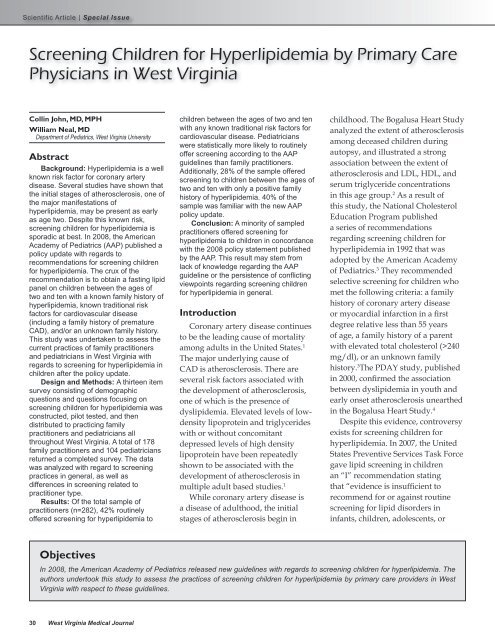Special CME Issue - West Virginia State Medical Association
Special CME Issue - West Virginia State Medical Association
Special CME Issue - West Virginia State Medical Association
You also want an ePaper? Increase the reach of your titles
YUMPU automatically turns print PDFs into web optimized ePapers that Google loves.
Screening Children for Hyperlipidemia by Primary Care<br />
Physicians in <strong>West</strong> <strong>Virginia</strong><br />
Collin John, MD, MPH<br />
William Neal, MD<br />
Department of Pediatrics, <strong>West</strong> <strong>Virginia</strong> University<br />
Abstract<br />
Background: Hyperlipidemia is a well<br />
known risk factor for coronary artery<br />
disease. Several studies have shown that<br />
the initial stages of atherosclerosis, one of<br />
the major manifestations of<br />
hyperlipidemia, may be present as early<br />
as age two. Despite this known risk,<br />
screening children for hyperlipidemia is<br />
sporadic at best. In 2008, the American<br />
Academy of Pediatrics (AAP) published a<br />
policy update with regards to<br />
recommendations for screening children<br />
for hyperlipidemia. The crux of the<br />
recommendation is to obtain a fasting lipid<br />
panel on children between the ages of<br />
two and ten with a known family history of<br />
hyperlipidemia, known traditional risk<br />
factors for cardiovascular disease<br />
(including a family history of premature<br />
CAD), and/or an unknown family history.<br />
This study was undertaken to assess the<br />
current practices of family practitioners<br />
and pediatricians in <strong>West</strong> <strong>Virginia</strong> with<br />
regards to screening for hyperlipidemia in<br />
children after the policy update.<br />
Design and Methods: A thirteen item<br />
survey consisting of demographic<br />
questions and questions focusing on<br />
screening children for hyperlipidemia was<br />
constructed, pilot tested, and then<br />
distributed to practicing family<br />
practitioners and pediatricians all<br />
throughout <strong>West</strong> <strong>Virginia</strong>. A total of 178<br />
family practitioners and 104 pediatricians<br />
returned a completed survey. The data<br />
was analyzed with regard to screening<br />
practices in general, as well as<br />
differences in screening related to<br />
practitioner type.<br />
Results: Of the total sample of<br />
practitioners (n=282), 42% routinely<br />
offered screening for hyperlipidemia to<br />
children between the ages of two and ten<br />
with any known traditional risk factors for<br />
cardiovascular disease. Pediatricians<br />
were statistically more likely to routinely<br />
offer screening according to the AAP<br />
guidelines than family practitioners.<br />
Additionally, 28% of the sample offered<br />
screening to children between the ages of<br />
two and ten with only a positive family<br />
history of hyperlipidemia. 40% of the<br />
sample was familiar with the new AAP<br />
policy update.<br />
Conclusion: A minority of sampled<br />
practitioners offered screening for<br />
hyperlipidemia to children in concordance<br />
with the 2008 policy statement published<br />
by the AAP. This result may stem from<br />
lack of knowledge regarding the AAP<br />
guideline or the persistence of conflicting<br />
viewpoints regarding screening children<br />
for hyperlipidemia in general.<br />
Introduction<br />
Coronary artery disease continues<br />
to be the leading cause of mortality<br />
among adults in the United <strong>State</strong>s. 1<br />
The major underlying cause of<br />
CAD is atherosclerosis. There are<br />
several risk factors associated with<br />
the development of atherosclerosis,<br />
one of which is the presence of<br />
dyslipidemia. Elevated levels of lowdensity<br />
lipoprotein and triglycerides<br />
with or without concomitant<br />
depressed levels of high density<br />
lipoprotein have been repeatedly<br />
shown to be associated with the<br />
development of atherosclerosis in<br />
multiple adult based studies. 1<br />
While coronary artery disease is<br />
a disease of adulthood, the initial<br />
stages of atherosclerosis begin in<br />
childhood. The Bogalusa Heart Study<br />
analyzed the extent of atherosclerosis<br />
among deceased children during<br />
autopsy, and illustrated a strong<br />
association between the extent of<br />
atherosclerosis and LDL, HDL, and<br />
serum triglyceride concentrations<br />
in this age group. 2 As a result of<br />
this study, the National Cholesterol<br />
Education Program published<br />
a series of recommendations<br />
regarding screening children for<br />
hyperlipidemia in 1992 that was<br />
adopted by the American Academy<br />
of Pediatrics. 3 They recommended<br />
selective screening for children who<br />
met the following criteria: a family<br />
history of coronary artery disease<br />
or myocardial infarction in a first<br />
degree relative less than 55 years<br />
of age, a family history of a parent<br />
with elevated total cholesterol (>240<br />
mg/dl), or an unknown family<br />
history. 3 The PDAY study, published<br />
in 2000, confirmed the association<br />
between dyslipidemia in youth and<br />
early onset atherosclerosis unearthed<br />
in the Bogalusa Heart Study. 4<br />
Despite this evidence, controversy<br />
exists for screening children for<br />
hyperlipidemia. In 2007, the United<br />
<strong>State</strong>s Preventive Services Task Force<br />
gave lipid screening in children<br />
an “I” recommendation stating<br />
that “evidence is insufficient to<br />
recommend for or against routine<br />
screening for lipid disorders in<br />
infants, children, adolescents, or<br />
Objectives<br />
In 2008, the American Academy of Pediatrics released new guidelines with regards to screening children for hyperlipidemia. The<br />
authors undertook this study to assess the practices of screening children for hyperlipidemia by primary care providers in <strong>West</strong><br />
<strong>Virginia</strong> with respect to these guidelines.<br />
30 <strong>West</strong> <strong>Virginia</strong> <strong>Medical</strong> Journal















